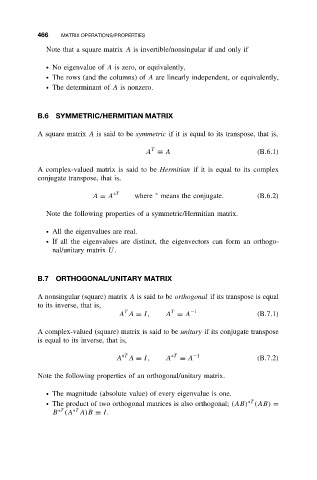Page 477 - Applied Numerical Methods Using MATLAB
P. 477
466 MATRIX OPERATIONS/PROPERTIES
Note that a square matrix A is invertible/nonsingular if and only if
ž No eigenvalue of A is zero, or equivalently,
ž The rows (and the columns) of A are linearly independent, or equivalently,
ž The determinant of A is nonzero.
B.6 SYMMETRIC/HERMITIAN MATRIX
A square matrix A is said to be symmetric if it is equal to its transpose, that is,
T
A ≡ A (B.6.1)
A complex-valued matrix is said to be Hermitian if it is equal to its complex
conjugate transpose, that is,
A ≡ A ∗T where ∗ means the conjugate. (B.6.2)
Note the following properties of a symmetric/Hermitian matrix.
ž All the eigenvalues are real.
ž If all the eigenvalues are distinct, the eigenvectors can form an orthogo-
nal/unitary matrix U.
B.7 ORTHOGONAL/UNITARY MATRIX
A nonsingular (square) matrix A is said to be orthogonal if its transpose is equal
to its inverse, that is,
T
T
A A ≡ I, A ≡ A −1 (B.7.1)
A complex-valued (square) matrix is said to be unitary if its conjugate transpose
is equal to its inverse, that is,
∗T
A A ≡ I, A ∗T ≡ A −1 (B.7.2)
Note the following properties of an orthogonal/unitary matrix.
ž The magnitude (absolute value) of every eigenvalue is one.
∗T
ž The product of two orthogonal matrices is also orthogonal; (AB) (AB) =
∗T
∗T
B (A A)B ≡ I.

